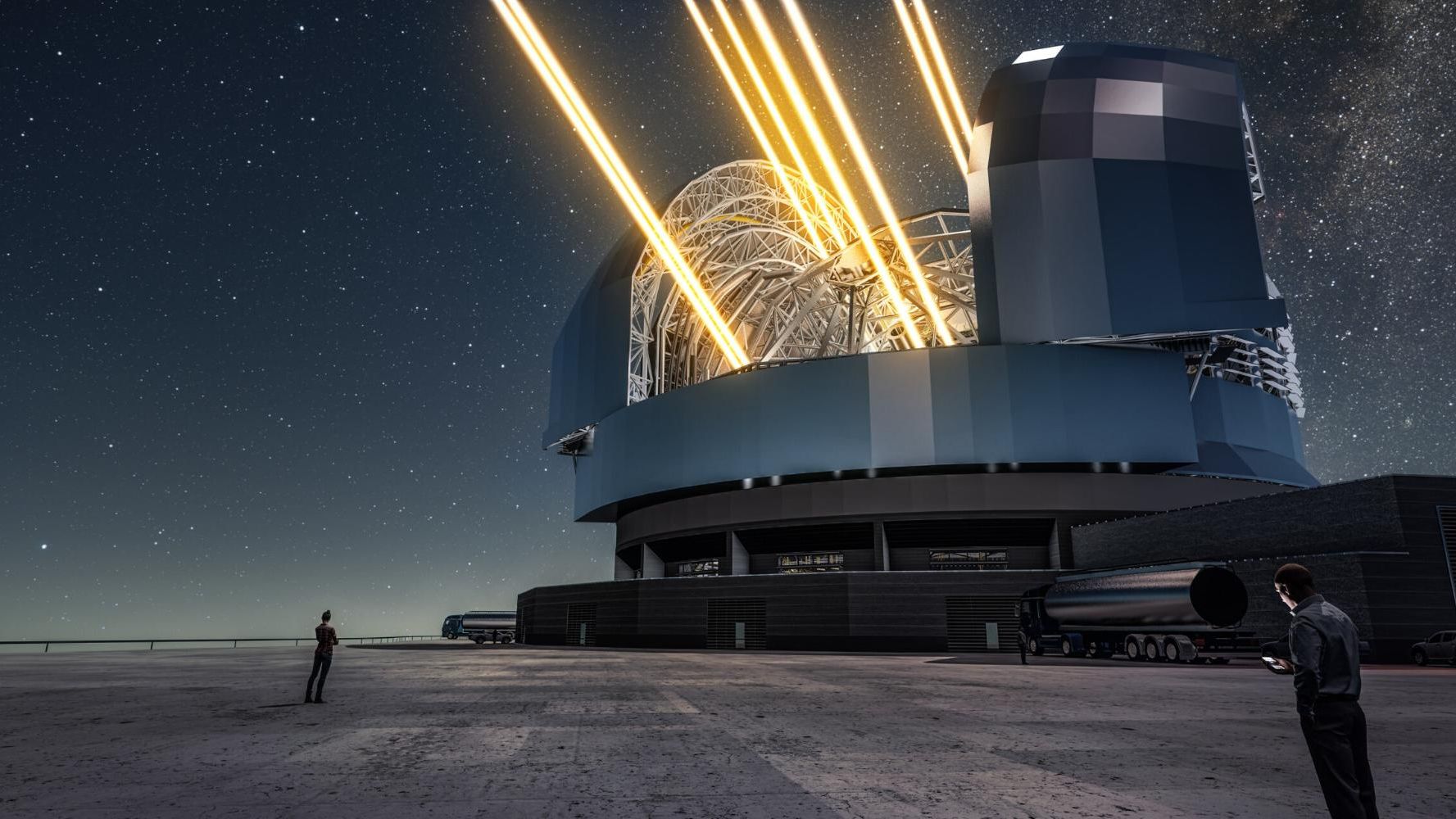Telescopes on Earth suffer from the atmosphere, which clouds their vision due to turbulence. That is why mega-telescopes such as the Very Large Telescope (VLT) and the Extremely Large Telescope (ELT) are located on a mountain top. This mountain top is located in Chile for the VLT, which consists of four telescopes, and the ELT, which is still under construction as the world’s largest telescope.
Artificial star as a benchmark
To further limit the effect of the remaining atmospheric disturbance, the Laser Projection System (LPS) has been developed. This instrument projects an artificial star onto the outer edge of the atmosphere at an altitude of ninety kilometers. Because the properties of this laser guide star are known, the influence of the atmosphere can be deduced from observations. Astronomers use this information to correct the images they are really interested in.
Follow-up to successful deployment
The laser guide star technology was developed more than ten years ago by ESO in collaboration with TNO, which built four LPS systems for one of the VLT telescopes. In fact, these were still prototypes, but they function well and indeed provide better observations. Therefore, ESO ordered another nine systems from TNO: three for the VLT (one for each of the three other telescopes) and six for the ELT. TNO decided to develop an improved, industrially mature version of the LPS, with a lot of attention to reliability, availability, maintainability and safety. For this complex example of precision optics and mechanics, TNO called on Demcon focal, a specialist in optomechatronic systems. Demcon focal took care of the laser adjustment and the control electronics. Naturally, there was close collaboration with TNO, because the various components had to fit together perfectly.
Improved system
The most important improvement in laser adjustment concerns maintenance, says Marko van Dalfsen, project leader at Demcon focal. “Sub-modules can now be interchanged very quickly and easily for service and maintenance. The system therefore has much less downtime. Astronomers can thus make more observations with their expensive telescopes.” In addition, the performance of the LPS has improved, adds TNO project manager Wouter Jonker. “Moreover, it has now become a robust system, which means we can easily build it in series. If ESO wants nine, we will supply nine.” Construction takes place at Demcon focal, Van Dalfsen reports. “Here, we assemble the components supplied by TNO and Focal into a complete system.”
Testing and training
The assembly of the first system has recently been completed. ESO conducted a test readiness review, an important milestone for shipment to ESO in Garching, near Munich (Germany). There, TNO will carry out tests in a climate chamber to test the system under the conditions that occur on a mountain top, Jonker reports. “We will also train ESO personnel in service, maintenance and operation of the system. ESO is expected to be able to officially install the system in the summer and use it for the first time in observations with a VLT telescope in mid-2025. A joint team from Demcon focal and TNO will help integrate the LPS on the telescope in Chile.” In the meantime, Demcon focal and TNO can start building systems two through nine. Here, ESO is in a hurry, because astronomers are eager for telescopes that provide sharper images. ‘First light’ on the ELT is planned for 2027.
More work for Demcon focal
The story is not over with the delivery of nine systems to ESO, Jonker acknowledges. “We are now finalizing a licensing agreement with ESO. This stipulates that we can use everything we have developed in this project in systems for other customers. Our system is absolutely unique worldwide. ESO will soon have the most beautiful stuff and we know that there are other observatories that would like to have it. I estimate that we can sell another twenty pieces.” A lot of work for Demcon focal can therefore result from this. “TNO will probably also transfer the production of the projection system to Demcon focal, because it is not our role to do series production.”
Knowledge transfer to industry
Albert Borreman, managing director of Demcon focal, is happy with all the work that comes to his company and also appreciates the knowledge transfer. “We often see that TNO knowledge gradually trickles down to the industry, in this case to Demcon focal. For example, the way designs are created and how certain lens mounting and connection principles are applied. I think it’s priceless how the industry is being taken along to slowly adopt new technology. It was also important for us to comply with ESO standards, so that we can now position ourselves as a partner for astronomy projects. We learned that in this project with the help of TNO.”
Equal partners
Above all, Borreman is proud of the end result. “We put a lot of time into it and carefully developed the design, with the result that many parts were ‘right first time’. We started in the time of Covid-19 and then there were the supply problems for crucial components that affected the entire industry; we survived these too. I attribute this to the efforts of the project team and the great collaboration.” There was certainly no standard customer-supplier relationship, confirms Wouter Jonker of TNO. “Contractually it may have been that, but in practice we worked together as equal partners.”
About Demcon
Demcon (1.000+employees) develops, produces, and supplies technology and innovative products. The Demcon group has locations in Best, Enschede, Delft, Groningen, Leiden, Maastricht (The Netherlands), Münster (Germany), Tokyo (Japan), and Singapore. The company was born out of the founders’ passion for combining creativity and technical skills to solve complex issues of a technological and social nature. In addition, Demcon is committed to stimulating entrepreneurship, and investing in talent and education.
Foto: ESO / www.eso.org

